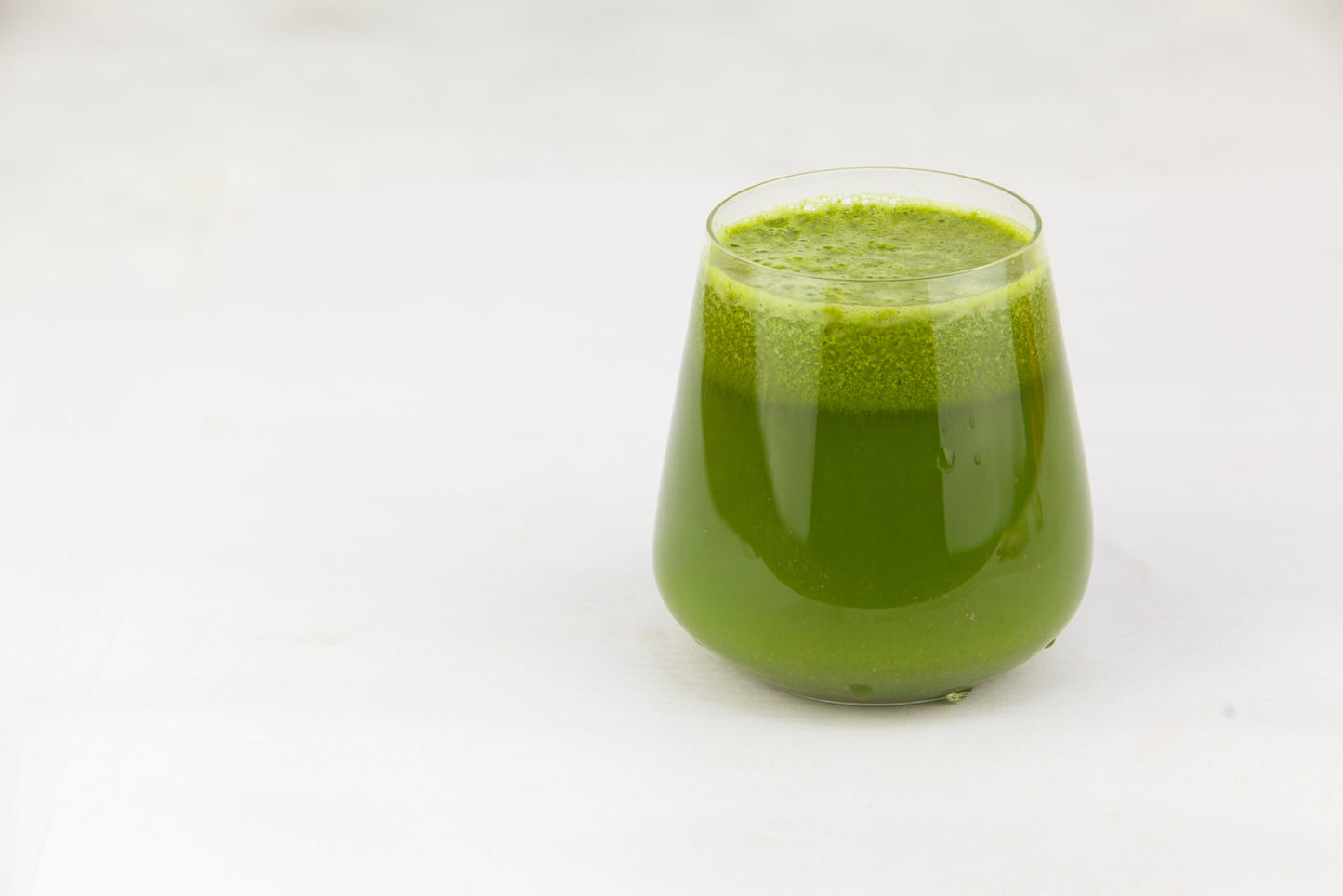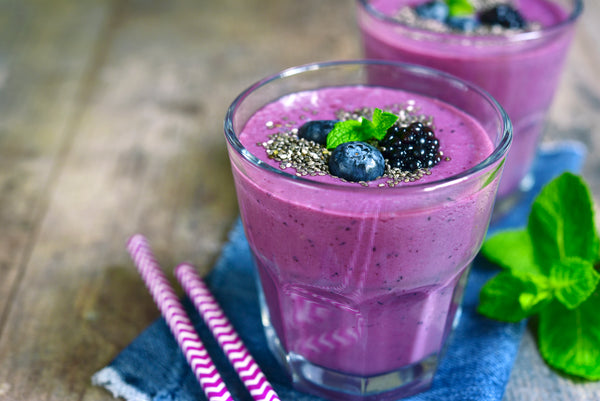
We’ve been getting a lot of questions lately about drinking calories. Seems appropriate, considering Ample is a meal in a bottle.
Is drinking your food somehow inferior to eating it? It’s a good question, and, as with most things in nutrition, the answer is more nuanced than a simple “yes” or “no.” There are both downsides and upsides to drinking your food. Let’s take a look at them.
Too much, too fast: the downsides of drinking a meal
There are two main downsides to drinking your calories:
1) It’s easy to drink a lot (especially when it comes to sugar)
A lot of juice companies highlight the number of fruits and veggies that fit into their juices. “This bottle contains: two green apples, a banana, half a mango, a head of lettuce, a cucumber, and a whole zucchini.”
Very impressive. But compare drinking that juice to chopping up all those fruits and vegetables, putting them into a bowl, and chewing your way through them.
You’ll get a lot more full actually eating the food. That’s partly because fiber is so filling (juicing removes fiber and leaves the sugar). The other reason actually is that it takes you longer to eat, which gives your intestinal lining time to register the food you’re eating and release hormones like CCK and PYY, which make you feel full (for more detail, check out our guide to satisfying food).


Basically, drinking food allows you to consume a lot in a couple minutes (or seconds), which can be a recipe for weight gain. Your body didn’t evolve to skip chewing and gulp down calories like that. It takes a few minutes for you to release satiety hormones that make you feel full. Chewing on solid food also releases those hormones – that’s why chewing your food makes you feel more full [1]. Drinking food in liquid form skips right by both of those systems, making it easy to take in some extra calories before your hunger signals kick in.
On top of that, the most common drinks – fruit juice, soft drinks, fruit smoothies, energy drinks, and even many protein shakes – have a lot of sugar. Sugary drinks will destabilize your insulin levels and send you on a sugar high, followed by a hunger-inducing crash a couple hours later. Sugar is also a major source of empty calories. If you're into healthy eating or you're looking for weight loss, you're best off avoiding high-sugar drinks. On a related note, diet soda and other drinks with artificial sweeteners may not be great for you either, and you'll definitely want to keep your alcoholic beverages in check.
2) You may not fully digest what you drink
Your body takes cues from your environment to prepare for incoming food – that’s why your mouth waters when you walk by a restaurant that’s frying bacon and roasting garlic. Maybe just reading that sentence got your mouth watering. The sight, smell, thought, and taste of food make you release stomach acid and digestion hormones, as well as enzymes in your saliva that break down what you eat as you chew (hence the mouthwatering sensation) [2]. This whole process is called the cephalic phase of digestion.
Drinking your food skips – or at least blunts – this part of digestion. A plate of sizzling steak with a side of grilled asparagus will trigger cephalic digestion a lot more than a protein shake with some greens powder added.
You’re sort of surprising your body when you drink food. It wasn’t expecting guests, so it hasn’t fully revved up its digestion. As a result, some of the food you drink may pass through your system undigested, or only partially digested.
We thought about all this when we made Ample, and countered it by making a lot of our nutrients particularly easy to digest. Our collagen protein, for example, is hydrolyzed – it’s already partially broken down, so enzymes in your small intestine don’t have to work as hard to extract nutrients from it. Similarly, we use lecithin to emulsify the fats in Ample – a job your liver and gallbladder would usually have to handle. We also added plenty of fiber, to make sure Ample is satisfying.
The pros of drinking a meal
On the other hand, there are some benefits to drinking calories.
1) Drinking is convenient


If you’re on the go and don’t have time for a sitdown meal, drinking becomes a positive, especially if you have something nutritious. A healthy drinkable meal is better than, say, drive-thru fast food. The four things to look for in a drinkable meal are fiber, protein, healthy fat, and low sugar (absolutely shameless plug: Ample has all four).
You may not be able to find fiber, protein, healthy fat, and low sugar all in one go when you’re traveling or busy, but there are plenty of readily available, drinkable options that at least partly fit the bill. Next time you’re in a bind on the road, turn to:
- A protein shake without added sugar
- A smoothie that’s mostly vegetables (a lot of smoothie places will take the fruit out of menu options. Many will also add protein if you ask)
- Coffee with healthy fat (cream is the standard, or you could blend it with grass-fed butter, coconut oil, or coconut milk if you’re keto)
- Greens powder mixed in water (have a jar of it in your car or bag)
Keep one of these handy for travel, or for busy days when you don’t have time to sit down to a meal.
2) Nutrient density in one meal
Drinking can also be useful for packing rare nutrients into a single meal. There’s major benefit to getting 6-8 servings of vegetables in a day, for example. But that’s a LOT of chewing to get through. It can be tough to heap four servings of greens on your plate for lunch and dinner. As a result, a lot of people don’t get enough fiber and are deficient in micronutrients like potassium, magnesium, and vitamins A, C, and E [3,4]. If you’re trying to build muscle, it can also be a slog to get enough protein to build lean body mass.
A well-designed shake can get you all your daily veggies, fiber, etc. in one go. Try blending the following:
- Two lemons, skin removed
- One lime, skin removed
- Half an avocado
- Two stalks celery
- Three leaves kale
- Handful of parsley
- Handful of cilantro
- One whole cucumber
- Thumb-size piece of ginger
- One banana (optional; omit if you eat low-carb)
- Grass-fed whey protein, or a vegan protein blend (optional)
- 8 ice cubes (blend them in at the end)
The result is a nutrient and fiber powerhouse with about 6 servings of veggies. This is where drinkable food becomes particularly valuable. Drink one of these shakes a day to take care of all your greens in one go.
Final thoughts
Drinking your calories isn’t inherently bad. As with all nutrition, it depends on what you’re putting in your body. Opt for nutrient-dense drinks with plenty of fiber, protein, and fat, and avoid drinks that concentrate sugar, even from natural fruits (your body doesn’t know the difference). Use drinkable meals to your advantage: fit solid nutrition into busy days, and pack in vegetables if you find you’re struggling to get enough.
Do you find benefit in drinking calories? Anything we missed? Leave your thoughts in the comments below. Thanks for reading and have a great week.
